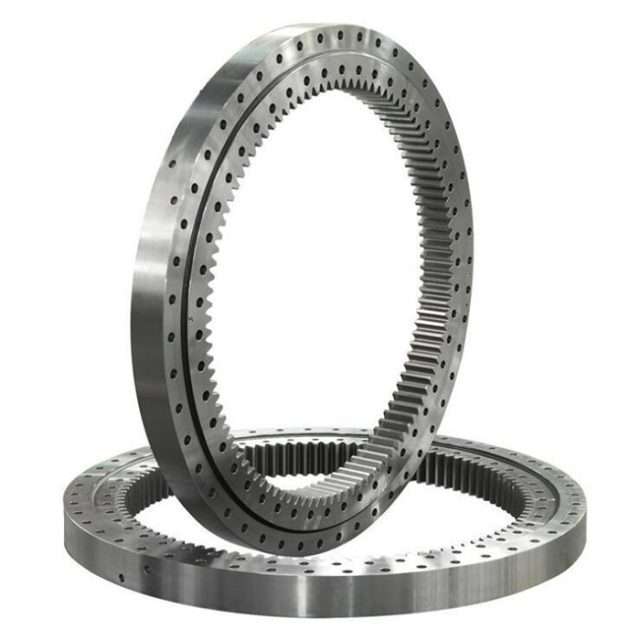in stock slewing bearings suppliers
Table of Contents
1.The difference between straight tooth slewing bearing and helical tooth slewing bearing
Slewing bearing, also known as slewing bearing, is a supporting and rotating component widely used in various types of mechanical equipment. Due to the transmission requirements, slewing bearings usually have teeth. The common ones are straight teeth and helical teeth. The most intuitive difference between straight teeth and helical teeth is that the shape of the gear is different. In addition, there are differences in load and noise.
1. Appearance
Gears with straight teeth are arranged in a straight line on the ring gear, while helical teeth are evenly distributed on the ring gear at an inclined angle.
2. Accuracy
The helical gear drive is easier to obtain high accuracy than the straight gear drive, and the helical gear accuracy is maintained for a longer time.
3. Noise
Due to the design, manufacture, structure and other reasons, the noise generated by the straight tooth itself is larger than that of the helical tooth drive. Because the straight tooth is in direct contact, the gears will vibrate when they are engaged. The occlusion of the helical teeth is gradually contacted and gradually separated, so the transmission of the helical teeth will be relatively stable and the vibration will be relatively small.
4. Efficiency
In terms of transmission efficiency, the transmission efficiency of straight teeth is higher than that of helical teeth, because helical teeth will generate axial component force during transmission, and will lose part of the input torque. Straight teeth do not have this problem, and the transmission efficiency is as high as 95%.
5. Meshing line
In the case of the same module and the same tooth height, the meshing line of the helical teeth is longer than that of the straight teeth when the gears are engaged. Torque will be higher. However, the meshing line of straight teeth is relatively short when occluding, the collision force of the teeth is relatively direct, the force range is shorter than that of helical teeth, and the torque it bears will also be smaller.

2.How to reduce slewing bearing tooth noise
The slewing bearing can stably support the equipment for slewing motion, also known as the turntable bearing. The mechanical equipment needs to be rotated without the transmission. The slewing bearing can be made of external teeth or internal teeth, and the slewing bearing can be rotated through the gear transmission.
In practical applications, the force of the slewing bearing is different, the speed of rotation is also different, and the teeth of the slewing bearing are also different. In the process of gear transmission, the contact between the gear and the ring gear of the slewing ring will generate noise, so how to reduce the noise of the slewing ring?
1. Control the tooth precision. Through long-term practice, we found that if we want to reduce the tooth noise, the tooth precision needs to be controlled at 7-8 grades. The higher the rotational speed, the higher the gear tooth precision requirements. Gear, tooth accuracy should be controlled within 7 grades.
2. Reduce the frequency of start-stop or forward and reverse rotation of the gear. Frequent start-stop or forward and reverse rotation will cause the gear to vibrate too fast, and the vibration will generate noise. The faster the vibration, the louder the noise. Reduce noise.
3. Reduce the impact load. The impact load will make the vibration frequency and torsion direction of the gear different, and will form vibration in the circumferential direction, which will form a smooth noise. Reducing the impact load can reduce the noise.
4. Reduce the occurrence of resonance, which will generate high-frequency noise. When the motor rotates at a low speed or at a certain speed, the equipment will resonate, causing the gear and ring gear to oscillate at a high frequency and the two oscillating objects will contact. High-frequency noise will be produced, which can generally be reduced by changing the speed or adjusting the position of the device.
5. Increase the roughness of the tooth surface. If the roughness of the tooth surface is very poor, it will cause point contact on the tooth surface, and noise will be generated when the high point contact is made. If the roughness of the tooth surface is increased, the tooth surface will be in line contact, and the noise will be very high. Small.
6. Increase the lubrication of the tooth surface. Insufficient lubrication will cause the friction force to increase, and noise will be generated when the tooth surface rubs. Sufficient lubrication can reduce friction and effectively reduce noise.

